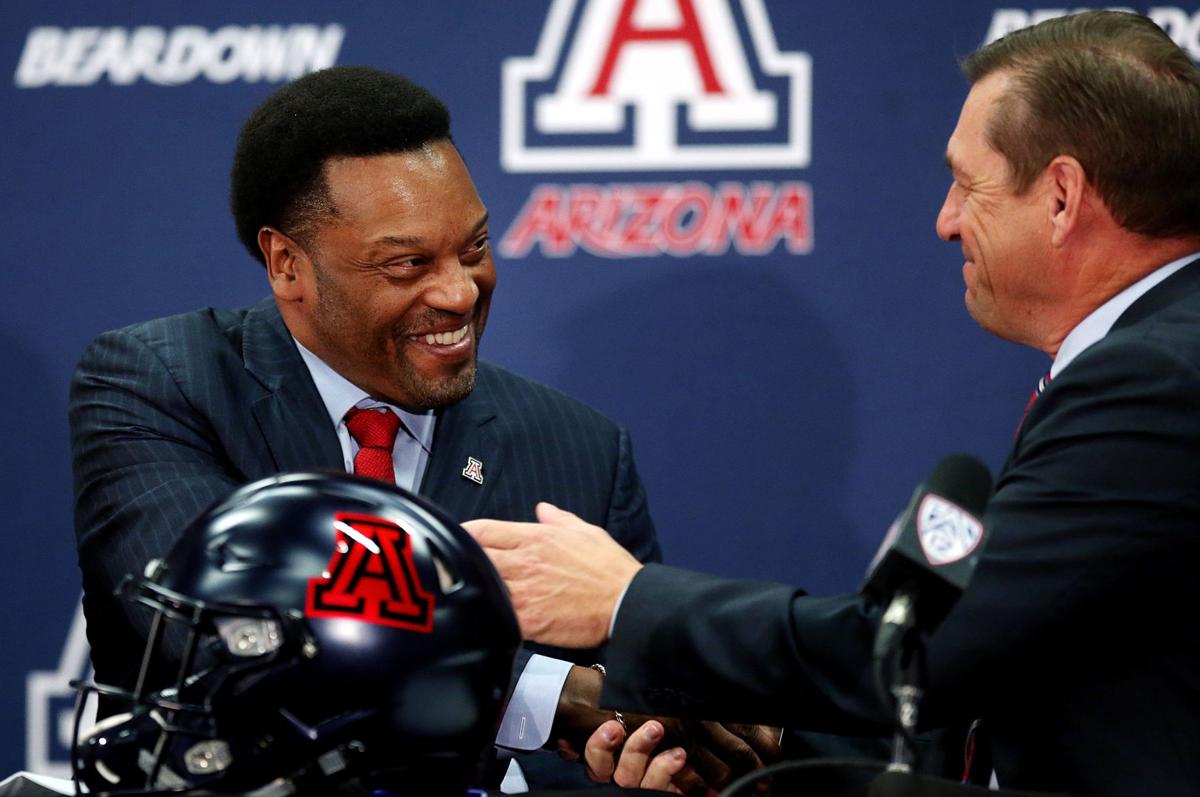The Arizona Wildcats paid Rich Rodriguez a $6.28 million buyout after an independent investigation into allegations of sexual harassment and running a hostile workplace found there was not enough evidence to fire him for cause.
Rodriguez’s replacement, Kevin Sumlin, was paid $10.4 million by Texas A&M to, essentially, go away.
Which is why the most important part of Tuesday’s announcement of Sumlin as Arizona’s new head coach came in one clause in one sentence of a six-page news release.
“Those provisions,” it read, noting Sumlin’s contract, “include a mitigation requirement.”
Mitigation clauses — essentially, firing insurance — are the new standard at Arizona, athletic director Dave Heeke said Tuesday.
Should Arizona decide to fire Sumlin at any point during his five-year, $14.5 million contract, he would be obligated to find work coaching football. And money earned in his next job would reduce the UA’s buyout to him.
Terms of Sumlin’s buyout were not immediately available, though Arizona officials revealed a rough framework of his contract before introducing him to the media on Tuesday.
Sumlin will earn a base of $2 million in 2018 and 2019 and $3.5 million per year over the following three seasons. Sumlin will owe the UA money if he leaves before the five-year term is up, and Arizona will buy him out — with the mitigation clause — if he is fired. The contract is subject to approval by the Arizona Board of Regents, which next meets Jan. 25.
Heeke said he’s been pushing for mitigation clauses since April, when he took over for the departed Greg Byrne.
Heeke has an ally in Regents Chairman Bill Ridenour, who said the board has grown tired of the UA cutting checks to underperforming employees. ASU paid Todd Graham a $12.2 million buyout after firing him in November. His replacement, Herm Edwards, signed a five-year deal that, like Sumlin’s, will pay him a $2 million base in 2018. Edwards’ deal comes with a mitigation clause: ASU would owe Edwards 100 percent of his buyout if it fires him and the coach is unable to land another Power 5 Conference job. If Edwards is fired and lands at another major-college program, ASU would owe him 50 percent of his remaining buyout.
Expect Sumlin’s contract to contain similar language.
“I’ve made it very clear to them — that is, the universities — that we need something like that in the contracts,” Ridenour said. “We would also prefer that, in the contracts, they enlarge the ‘for cause’ paragraphs in the contracts to cover other eventualities other than ‘not able to perform their jobs.’”
Rodriguez was fired Jan. 2, five days after a $7.5 million notice of claim was filed against the coach by his former administrative assistant. In it, Melissa Wilhelmsen claims that Rodriguez made passes at her, forced her to cover up his extramarital affair and kept a “Hideaway Book” detailing some of his politically incorrect beliefs. Among them: That Title IX, the gender-equity law, “doesn’t exist in our office.”
But even if Rodriguez’s contract had a more detailed “for cause” section, Arizona would’ve been on the hook for his buyout, Ridenour said.
“We cannot terminate a contract for cause based on allegations which are, at this point, unsubstantiated,” he said.
Mitigation clauses are commonplace in professional sports, but relatively rare in major college athletics. The Arizona schools traditionally didn’t include them, Ridenour said, to make the jobs look more appealing to candidates.
“To attract these coaches,” Ridenour said, “it’s been a very difficult market.”
Yet Arizona emerged from its 12-day coaching search with a coach who would’ve been near the top of most schools’ lists. Sumlin and Heeke met twice face-to-face. A deal came together quickly Saturday night and Sunday morning, with the two agreeing to terms Sunday afternoon.
The deal “shows a great commitment on both sides,” Heeke said.
And provides some coverage if Arizona must fire another football coach.





